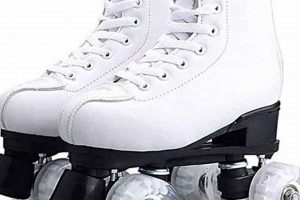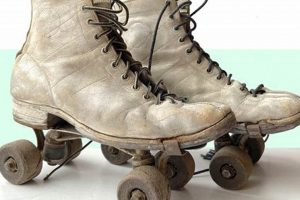The ability to decelerate and halt while using wheeled boots is a fundamental skill. Mastering effective braking techniques ensures safety and control during recreational or competitive activities. These techniques are crucial for navigating various terrains and avoiding collisions.
Proficiently managing velocity is vital for the overall enjoyment and safety of the activity. Historically, rudimentary methods were employed, often relying on friction against surfaces. Modern techniques offer more controlled and efficient ways to reduce speed and come to a complete standstill, thus minimizing risk and enhancing maneuverability.
The following sections will detail several established methods for controlling speed, ranging from beginner-friendly options to more advanced maneuvers. Each method will be explained with a focus on proper execution and the conditions under which it is most effective.
Effective Speed Management Techniques
Effective management of wheeled boot velocity relies on understanding and applying various physical principles. Mastering these techniques will contribute to improved safety and control in diverse skating environments.
Tip 1: The heel brake, typically located on one boot, offers a primary means of speed reduction. Apply pressure to the braking foot by raising the toes and pressing the heel downward. Modulate pressure for gradual deceleration.
Tip 2: The T-stop provides a more advanced method. Position the non-dominant foot perpendicular behind the dominant foot, forming a “T” shape. Apply pressure to the rear wheels while maintaining balance to induce controlled drag.
Tip 3: The plow stop, also known as the snowplow stop, involves angling both feet inward, creating a V-shape. Apply pressure to the inside edges of the wheels to generate friction and reduce speed.
Tip 4: For emergency situations, consider controlled falls. Lower the body’s center of gravity and attempt to land on padded areas such as the buttocks or forearms, dispersing the impact force.
Tip 5: Prioritize smooth surfaces when practicing and implementing these techniques. Uneven terrain can affect balance and control, diminishing the effectiveness of braking efforts.
Tip 6: Regularly inspect and maintain wheeled boot equipment. Worn brake pads or wheels compromise stopping ability, potentially leading to hazardous situations.
Consistent practice and mindful application of these speed management techniques will build confidence and ensure greater control while using wheeled boots. Understanding the dynamics of each technique allows for safer navigation in various conditions.
With a solid foundation in speed management, the focus can shift towards navigating complex scenarios and advanced maneuvers, further enhancing the wheeled boot experience.
1. Braking mechanism maintenance
Effective deceleration when using wheeled boots is intrinsically linked to the condition and functionality of the braking system. Neglecting the maintenance of these mechanisms can significantly compromise stopping ability, increasing the risk of accidents and injuries.
- Brake Pad Condition
The brake pad is the component directly responsible for generating friction against the wheel surface. Over time, the pad material wears down, reducing its effectiveness. Regular inspection and timely replacement of worn pads are crucial for maintaining optimal stopping power. For instance, if a skater notices an increased distance required to come to a complete stop, it is a strong indicator that the brake pad needs replacement.
- Brake Mount Security
The brake mount secures the brake pad assembly to the boot. A loose or damaged mount can cause instability and reduced braking efficiency. Periodic checks to ensure the mount is firmly attached and free from damage are necessary. Example: A cracked brake mount could cause the brake to detach during use, resulting in loss of control.
- Wheel Integrity
While not directly part of the braking mechanism, the condition of the wheels influences stopping performance. Worn, uneven, or improperly inflated wheels can reduce the effectiveness of braking systems. Maintaining wheels in optimal condition contributes to consistent and predictable stops. For example, severely worn wheels will cause braking to be inconsistent and increase the chance of slippage. This can also effect the surface of the braking mechanism and damage both.
- Hardware Inspection
Braking systems often involve various screws, bolts, and other small hardware components. These components should be regularly inspected for tightness and corrosion. Loose or corroded hardware can compromise the integrity of the entire braking system. An example would be if the screw holding the pad to the mount corrodes. The pad may separate from the mount when attempting to brake, causing accidents.
In conclusion, consistent braking mechanism maintenance is not merely a preventative measure but a fundamental aspect of responsible wheeled boot usage. Ensuring each component is in proper working order directly translates to enhanced safety, control, and overall enjoyment of the activity. Neglecting this maintenance carries significant risks, underscoring the importance of routine inspections and timely repairs.
2. Surface condition awareness
Surface conditions profoundly impact the efficacy of deceleration techniques. The interaction between wheeled boot wheels and the ground dictates the available friction, directly influencing stopping distance and control. Therefore, an acute awareness of surface properties constitutes a vital component of safe wheeled boot operation. Changes in surface texture, the presence of debris, and moisture levels significantly alter braking performance.
For example, a transition from smooth asphalt to rough concrete will typically increase friction, allowing for quicker stops. Conversely, loose gravel, sand, or other debris reduces friction, extending stopping distances and increasing the likelihood of skidding. Wet surfaces, especially when combined with painted lines or metal surfaces, can drastically diminish braking ability, presenting a significant hazard. Consider a scenario where a skater anticipates a controlled stop on dry pavement, only to encounter an unseen patch of oil. The sudden reduction in friction could lead to a loss of control and a potential collision.
Effective wheeled boot usage necessitates constant assessment of the skating environment. This includes visually scanning the path ahead for potential hazards and adjusting braking techniques accordingly. In situations where surface conditions are compromised, skaters should reduce their speed and increase the distance between themselves and other objects or individuals. Understanding the interplay between surface conditions and wheeled boot wheels is not merely theoretical; it is a practical necessity for safe and responsible skating.
3. Balance control proficiency
Balance control proficiency is inextricably linked to the ability to effectively decelerate and halt while using wheeled boots. The ability to maintain equilibrium during the deceleration process is paramount for executing controlled stops and preventing falls. A lack of balance control can significantly impair the effectiveness of any stopping technique, regardless of the skater’s skill level with the technique itself. For instance, attempting a T-stop without adequate balance will likely result in the skater losing their center of gravity, causing a wobble or an uncontrolled slide, thus negating the intended braking effect.
Further demonstrating this connection, consider the application of the heel brake. While seemingly straightforward, successful execution requires the skater to shift their weight and maintain balance on one leg while applying pressure to the brake. Insufficient balance control can lead to instability, causing the skater to swerve or lose control, particularly at higher speeds. Moreover, proficient balance allows for the absorption of momentum changes during the braking process, mitigating the risk of sudden jolts or falls. This is critical when navigating uneven terrain or unexpected obstacles, where the ability to adjust balance instantaneously can prevent accidents.
In summary, balance control proficiency serves as a foundational skill for all deceleration techniques used with wheeled boots. It enables the skater to maintain stability, modulate braking force effectively, and react to unforeseen circumstances. The development of balance control should, therefore, be prioritized alongside the learning of specific stopping maneuvers. Achieving mastery in both areas contributes significantly to overall safety and confidence while using wheeled boots.
4. Speed assessment accuracy
Accurate evaluation of velocity is intrinsically linked to the effectiveness of any deceleration method when using wheeled boots. The ability to gauge one’s speed precisely dictates the selection of the appropriate braking technique and the amount of force required to achieve a controlled stop. Underestimation or overestimation of velocity can compromise safety and increase the risk of accidents.
- Technique Selection
The choice of stopping method hinges on a precise understanding of current velocity. At low speeds, a simple heel brake may suffice. However, higher velocities necessitate more aggressive techniques such as the T-stop or plow stop. An inaccurate speed assessment can lead to the selection of an inadequate braking method, resulting in a failure to decelerate sufficiently. For example, attempting a heel brake at excessive speeds may cause instability and loss of control, increasing the risk of a fall.
- Force Modulation
Effective deceleration requires the careful modulation of braking force. The amount of pressure applied to the braking mechanism must be proportional to the skater’s speed. An overestimation of velocity may result in the application of excessive force, causing abrupt stops and potential loss of balance. Conversely, an underestimation may lead to insufficient braking force, resulting in continued forward momentum and a failure to avoid obstacles. This is particularly crucial in crowded environments where precise speed control is paramount.
- Environmental Awareness
Speed assessment is intrinsically linked to environmental awareness. Skaters must consider factors such as surface conditions, inclines, and potential hazards when evaluating their velocity. An inaccurate assessment of speed in relation to these factors can lead to misjudgments and dangerous situations. For example, failing to account for a downhill slope can result in an underestimation of velocity, leading to a failure to brake effectively and a potential collision. Therefore, an integration of environmental awareness into the speed assessment process is vital.
- Anticipatory Braking
Accurate speed evaluation allows for anticipatory braking, which involves initiating deceleration before reaching a point of potential conflict or hazard. This proactive approach requires the skater to constantly monitor their speed and surroundings, anticipating the need to slow down or stop. Inaccurate speed estimation can impede anticipatory braking, leading to delayed reactions and a reduced margin of safety. Consistent speed monitoring facilitates timely adjustments to braking force, minimizing the risk of accidents.
In summary, speed assessment accuracy is not merely a peripheral skill but a fundamental component of safe and controlled wheeled boot operation. Accurate evaluation of velocity enables skaters to select appropriate braking techniques, modulate braking force effectively, and anticipate potential hazards. The integration of speed assessment with environmental awareness promotes proactive decision-making, enhancing overall safety and minimizing the risk of accidents.
5. Technique adaptation capability
The capacity to modify deceleration strategies based on situational variables is a critical determinant of safe and effective wheeled boot operation. This adaptation capability transcends rote application of fixed techniques, demanding a dynamic assessment and modification of stopping methods aligned with prevailing conditions.
- Surface Condition Adjustment
Varying surfaces necessitate distinct braking approaches. On smooth, dry pavement, a standard heel brake may prove sufficient. However, encountering wet, uneven, or debris-laden surfaces requires a shift to techniques that provide greater control and friction, such as the T-stop or plow stop. Failure to adapt to compromised surfaces elevates the risk of skidding and uncontrolled movement.
- Velocity-Responsive Modification
Different velocities demand adjustments in braking intensity and method. At lower speeds, gradual deceleration may suffice, minimizing disruption to balance. Higher velocities, however, necessitate more aggressive techniques applied with greater force. Attempting a slow-speed braking technique at high speed will likely prove ineffective, while applying excessive force at low speed could lead to a loss of stability.
- Obstacle Avoidance Integration
The presence of obstacles necessitates adaptations to braking strategies. Direct, linear stops may not always be feasible in crowded environments or when encountering sudden obstructions. In such cases, skaters must integrate braking maneuvers with evasive techniques, such as controlled turns or subtle shifts in direction, to avoid collisions. Rigid adherence to a single braking method can prove detrimental in complex environments.
- Equipment-Related Accommodations
The condition and type of wheeled boot equipment influence braking technique adaptation. Worn brake pads or wheel bearings necessitate adjustments in force and timing to compensate for reduced performance. Similarly, variations in wheel durometer (hardness) affect grip and braking efficiency. Skaters must adapt their techniques to account for the specific characteristics and limitations of their equipment.
The integration of these adaptive skills is essential for safe and effective wheeled boot usage. Proficient skaters possess the ability to seamlessly transition between braking techniques, modulating force and adjusting their approach based on a continuous assessment of environmental conditions, velocity, obstacles, and equipment status. This dynamic adaptation capability significantly enhances safety and control across diverse skating scenarios.
Frequently Asked Questions
This section addresses common inquiries regarding controlled deceleration and halting procedures when using wheeled boots. The aim is to clarify best practices and address misconceptions concerning safe and effective stopping techniques.
Question 1: Is the heel brake universally effective across all terrains?
The heel brake provides a reliable stopping mechanism on smooth, dry surfaces. However, its effectiveness diminishes on wet, uneven, or steeply inclined terrains. Alternative techniques, such as the T-stop or plow stop, are generally recommended for challenging conditions.
Question 2: How frequently should brake pads be inspected?
Brake pad inspection frequency depends on usage intensity and environmental conditions. Regular inspection, ideally before each session, is recommended. Replace brake pads exhibiting significant wear or compromised braking performance immediately.
Question 3: Does the T-stop technique damage wheel surfaces?
The T-stop technique, while effective, does induce wear on the wheels of the braking foot. Rotating wheels periodically can mitigate uneven wear patterns. Monitor wheel condition closely and replace wheels as necessary to maintain optimal performance.
Question 4: Can stopping techniques be effectively learned independently?
While independent practice is possible, formal instruction is highly recommended. Qualified instructors provide guidance on proper form and technique, reducing the risk of injury and accelerating the learning process. Consider supervised sessions to enhance proficiency and confidence.
Question 5: What role does body weight play in braking effectiveness?
Body weight distribution significantly impacts braking effectiveness. Centering weight over the braking foot enhances stability and maximizes friction. Leaning back excessively reduces braking force and increases the risk of losing control.
Question 6: Are there specific braking techniques recommended for emergency situations?
In emergency situations, prioritizing controlled deceleration is paramount. Employing the T-stop or plow stop offers more rapid deceleration compared to the heel brake. If a collision is imminent, consider a controlled fall to minimize potential injury.
Mastering controlled deceleration techniques is essential for ensuring safe and enjoyable wheeled boot experiences. Prioritizing proper form, regular equipment maintenance, and adaptation to environmental conditions will contribute significantly to skill development and accident prevention.
The subsequent section will explore strategies for navigating crowded environments while maintaining safe operational practices.
Conclusion
This exploration of how to stop roller skates has detailed several fundamental techniques, emphasizing the critical role of balance, surface awareness, equipment maintenance, and adaptable execution. Mastery of these deceleration methods is not merely a matter of skill acquisition; it is a prerequisite for responsible wheeled boot operation.
Consistent practice and diligent application of these principles significantly mitigate the risks associated with this activity, fostering a safer environment for all participants. Continued dedication to refining stopping proficiency remains paramount for responsible and controlled wheeled boot usage.







